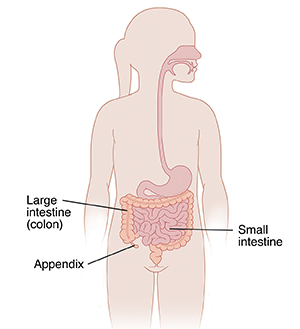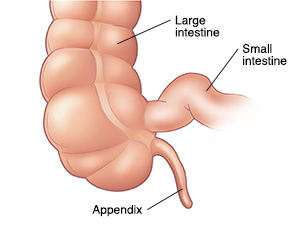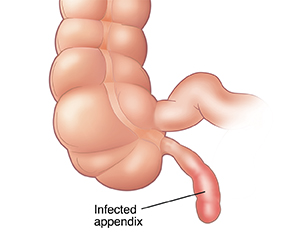When Your Child Has Appendicitis
The appendix is a small, hollow piece of tissue attached to the colon (large intestine) where it meets the small intestine. An infection of the appendix is called appendicitis. Surgery is most often needed right away to remove an infected appendix. Your child's healthcare provider will tell you more about your child’s condition. They will tell you what your choices are.

The appendix
Waste moves through the colon and passes in and out of the appendix. In some cases, waste can be trapped inside the appendix. When this happens, an infection can form. An infected appendix can swell and then burst (rupture). This can be very dangerous. This is why surgery is often done right away to remove the appendix before it bursts. Sometimes an appendix bursts and a pocket of infection (abscess) forms. This will be drained. Antibiotics may need to be given for some time (can be weeks) before the appendix is removed.

 |
| Surgery is needed to remove an infected appendix before it ruptures. |
What are the symptoms of appendicitis?
Symptoms can appear very quickly. They may happen in a few hours or in 1 to 2 days. They may include:
-
Pain that starts in the center of the belly and moves to the lower right side
-
Pain that gets worse with walking
-
Upset stomach or vomiting
-
Low appetite
-
Fever
-
Extreme tiredness (fatigue)
-
Loose, watery stool (diarrhea) or hard, dry stool (constipation)
How is appendicitis diagnosed?
An exam will be done to find the source of your child’s pain. Tests may be done if needed. These include blood tests and urine tests. A test that takes a picture of the belly may be done. This might be an X-ray, ultrasound, or CT scan.
How is appendicitis treated?
Surgery is done to take out the appendix. This is called an appendectomy. It may be done in 1 of 2 ways:
-
Open surgery. A single cut (incision) 2 or 3 inches long is made in the lower right part of the belly. If the appendix has burst, the cut may need to be bigger.
-
Laparoscopic surgery. Between 1 and 4 small cuts are made in the belly. A thin, lighted tube with a camera (laparoscope) is used. It is put through 1 cut. It shows the inside of the belly on a screen. Tools are put into the other cuts. In some cases, the surgeon may need to change a laparoscopic surgery to open surgery for your child's safety.
The cuts will be closed with glue, stitches, or staples. A tube may be used for a short time. This is done to drain fluid. If the appendix has burst, the cut may be left open. This lets it drain more easily. It may heal on its own. Or it may be closed 4 or 5 days later.
Your child’s recovery
Your child will likely stay in the hospital for 1 to 2 days. If the appendix has burst, the stay may be a week or more. During this time:
-
Your child will be given medicine to help ease pain.
-
Fluids may be given through an IV (intravenous) line.
-
Antibiotics may be given to prevent or fight infection.
-
Your child will be given only liquids at first. This is to let the colon heal. Solid food is then slowly started again.
-
Don't let your child do any heavy lifting, contact sports, or rough play for 3 to 4 weeks. Once the cuts heal, your child can go back to all activities.
Call the healthcare provider
Call your child's healthcare provider if any of these occur:
-
Signs of infection at the cut site. This includes swelling, drainage, pain that gets worse, or abnormal redness.
-
Fever of 100.4°F (38°C) or higher, or as advised by the provider
-
Belly pain that gets worse
-
Severe diarrhea, bloating, or constipation
-
Upset stomach or vomiting